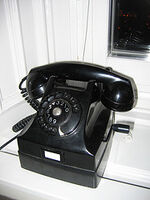Chicagogreen (talk | contribs) (Deleted sections about the Borg and the murderous American society because they were non-pertinent) |
Chicagogreen (talk | contribs) |
||
| Line 10: | Line 10: | ||
===The Mouse=== |
===The Mouse=== |
||
| ⚫ | In the early days of [[Computer| computers]], the only way to navigate through the graphic interface was exclusively done by use of the keyboard. That all changed when researcher Douglas Engelbart of the Standard Research Institute invented ''The Mouse'', a pointing device that could be moved by the user's hand on an X/Y axis. The movement of the mouse corresponds with a pointer on the computer screen to help humans easily navigate through the graphical interface, along with buttons tied to functions or commands, as if the user was manipulating the computer with his/her fingers. The Mouse was a breakthrough in combining hand-eye coordination in computer usage for a natural interactive navigational interface. The Mouse has changed over the years, adding more buttons, removing the ball in favor of optics, becoming more ergonomic, and even becoming wireless for added convenience. |
||
| − | |||
| ⚫ | In the early days of [[Computer| computers]], the only way to navigate through the graphic interface was exclusively done by use of the keyboard. That all changed when researcher [[Douglas Engelbart]] of the Standard Research Institute invented ''The Mouse'', a pointing device that could be moved by the user's hand on an X/Y axis. The movement of the mouse corresponds with a pointer on the computer screen to help humans easily navigate through the graphical interface, along with buttons tied to functions or commands, as if the user was manipulating the computer with his/her fingers. The Mouse was a breakthrough in combining hand-eye coordination in computer usage for a natural interactive navigational interface. The Mouse has changed over the years, adding more buttons, removing the ball in favor of optics, becoming more ergonomic, and even becoming wireless for added convenience. |
||
==External Links== |
==External Links== |
||
Revision as of 15:03, 5 March 2008
Anthropotropism is the principle that technologies work better when they respect the nature of the human body and the human mind. Alternatively, as media evolve they replicate human characteristics, behavior and/or adapt to them. The concept is most commonly associated with media scholar and science-fiction author Paul Levinson and his book, The Soft Edge.
Examples of Anthropotropism
The Telephone

An old Telephone
Once connected to the wall, users were forced to walk over to the phone when it rang. Later, car phones became available to give people a place to make and receive calls outside of the home or office. And now, phones are highly portable, relying only on their distance from Cell Towers. They are being re-shaped to better adapt to the form of the human face, freeing users to use their hands freely when they talk, as they would if they were speaking with someone in the same room.
The Mouse
In the early days of computers, the only way to navigate through the graphic interface was exclusively done by use of the keyboard. That all changed when researcher Douglas Engelbart of the Standard Research Institute invented The Mouse, a pointing device that could be moved by the user's hand on an X/Y axis. The movement of the mouse corresponds with a pointer on the computer screen to help humans easily navigate through the graphical interface, along with buttons tied to functions or commands, as if the user was manipulating the computer with his/her fingers. The Mouse was a breakthrough in combining hand-eye coordination in computer usage for a natural interactive navigational interface. The Mouse has changed over the years, adding more buttons, removing the ball in favor of optics, becoming more ergonomic, and even becoming wireless for added convenience.
External Links
- We reinvented the brain from Whats New Media?
- Why New Media Matter from Evolutionarymedia.com